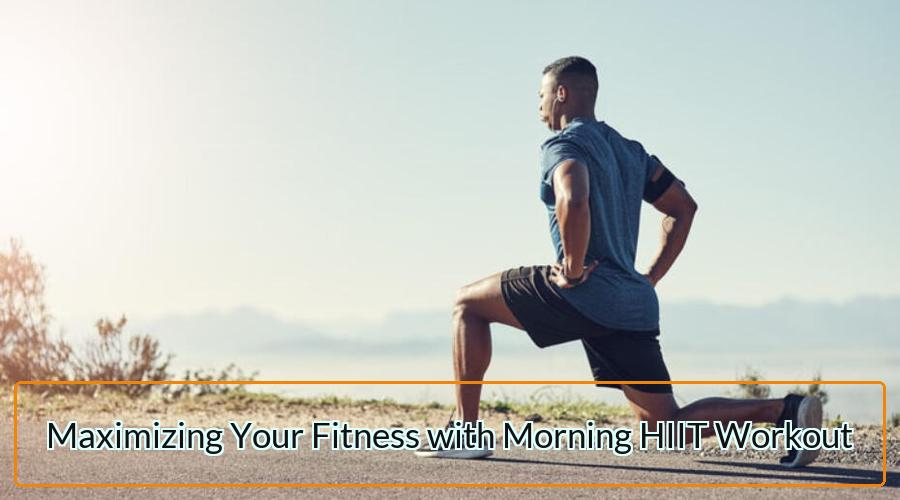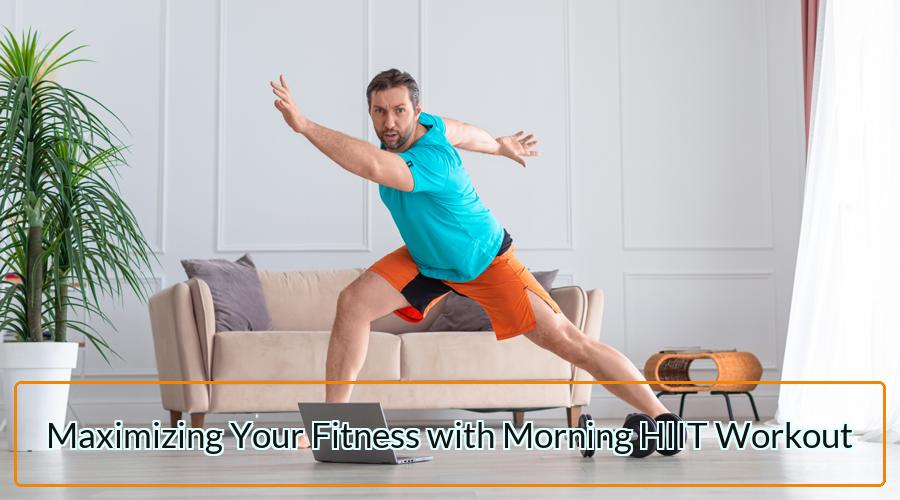
Do you often feel sluggish and unmotivated in the morning, struggling to muster the energy to start your day? A great way to get yourself moving and feeling energized is to do a quick workout as soon as you wake up. And one of the best types of workouts for this purpose is HIIT – High-Intensity Interval Training.
HIIT workouts are designed to get your heart pumping and your blood flowing in short, intense bursts. They’re great for people who want to maximize their exercise time and see results quickly. And if you do them in the morning, they can set you up for a day of increased productivity and focus.
In this post, we’ll explore the benefits of doing a morning HIIT workout and provide you with a few quick and effective exercises to try out for yourself. We’ll also explain how you can tailor your workout to your fitness level and preferences, so you can make the most of your exercise routine. So, if you’re ready to start your day with a burst of energy, read on to learn more!
The Science Behind HIIT Workouts
HIIT stands for High-Intensity Interval Training, and it’s a type of workout that involves short, intense bursts of exercise followed by periods of rest or low-intensity exercise. The idea behind HIIT is to get your heart rate up quickly and keep it there for short periods of time, followed by brief periods of recovery. This cycle of high-intensity exercise followed by rest or recovery is repeated for a set amount of time, usually ranging from 10 to 30 minutes.
HIIT can be done with a variety of exercises, such as running, cycling, jumping jacks, and burpees, among others. The key is to choose exercises that elevate your heart rate quickly and keep it there for the duration of the high-intensity interval.
The benefit of HIIT is that it allows you to get a lot of exercise in a short amount of time, which is great for busy people who want to see results quickly. It also increases your metabolism, which means you’ll continue burning calories even after you’ve finished your workout. Additionally, HIIT has been shown to improve cardiovascular health, increase insulin sensitivity, and decrease the risk of chronic diseases such as type 2 diabetes and heart disease.
Read more about CrossFit Workouts with Deadlifts
Benefits of HIIT
There are several benefits to incorporating High-Intensity Interval Training (HIIT) into your fitness routine. Here are some of the most significant benefits of HIIT:
- Increased calorie burn: HIIT is an effective way to burn calories quickly, as it involves short bursts of high-intensity exercise followed by brief periods of rest. This helps to boost your metabolism and keep it elevated for hours after your workout.
- Improved cardiovascular health: HIIT can help to improve your heart health by increasing your heart rate during exercise and lowering your resting heart rate over time. This can reduce your risk of developing heart disease and other chronic conditions.
- Time-efficient: HIIT workouts are typically shorter than traditional workouts but can be just as effective. This makes them ideal for people with busy schedules who want to maximize their exercise time.
- Increased muscle tone: HIIT workouts can help to build lean muscle mass and improve overall muscle tone. This is because the intense intervals put a significant amount of stress on the muscles, forcing them to adapt and grow stronger.
- Lowered insulin resistance: HIIT has been shown to improve insulin sensitivity, which can help to reduce the risk of developing type 2 diabetes.
Overall, HIIT is a highly effective way to improve your fitness level, burn calories, and reduce your risk of chronic disease. It’s also a fun and challenging workout that can help you to achieve your fitness goals quickly and efficiently.
How to Design a HIIT Workout
When designing a HIIT workout, there are a few key things to keep in mind to ensure that it is effective and safe. Here are some tips for designing a HIIT workout:
- Choose your exercises: The first step in designing a HIIT workout is to choose the exercises that you want to include. These can be any exercises that elevate your heart rate quickly and keep it there for short periods of time, such as jumping jacks, burpees, or high knees.
- Determine your work and rest intervals: Once you have chosen your exercises, you will need to determine the length of your high-intensity intervals and your rest intervals. A typical work-to-rest ratio for HIIT is 1:2 or 1:3. For example, you might do 30 seconds of high-intensity exercise followed by 60 or 90 seconds of rest or low-intensity exercise.
- Warm-up properly: Before you begin your HIIT workout, it’s important to warm up properly to prevent injury and prepare your body for the intense exercise to come. This can include a few minutes of light cardio, such as jogging or jumping jacks, followed by some dynamic stretching.
- Start with a low-intensity interval: To ease into your HIIT workout, start with a low-intensity interval that gradually increases in intensity. This can help to prevent injury and prepare your body for the more intense intervals to come.
- Increase intensity gradually: As you progress through your HIIT workout, gradually increase the intensity of your high-intensity intervals. This will help you to gradually build up your fitness level and prevent injury.
- Cool down properly: After your HIIT workout, it’s important to cool down properly to bring your heart rate back down to normal and prevent injury. This can include a few minutes of light cardio followed by some static stretching.
By following these tips, you can design a safe and effective HIIT workout that will help you to achieve your fitness goals.
Read more about Pre Workout vs Protein Powder

Quick HIIT Exercises to Boost Your Energy
There are many effective HIIT exercises that you can do to boost your energy and get your heart pumping. Here are a few quick and easy exercises to try:
- Jumping Jacks: Start with your feet together and your hands at your sides. Jump your feet out to shoulder-width apart while simultaneously raising your arms above your head. Jump back to starting position and repeat for 30 seconds.
- Burpees: Start in a standing position, then squat down and place your hands on the ground in front of you. Jump your feet back into a plank position, then jump them back in towards your hands. Stand up and jump into the air, then repeat for 30 seconds.
- Mountain Climbers: Start in a plank position, with your hands directly under your shoulders and your body in a straight line. Bring one knee up towards your chest, then quickly switch legs, bringing the other knee up towards your chest. Repeat for 30 seconds.
- High Knees: Stand with your feet hip-width apart and your arms at your sides. Quickly alternate lifting your knees up towards your chest while pumping your arms. Repeat for 30 seconds.
- Squat Jumps: Start in a squat position with your feet shoulder-width apart. Jump up explosively, reaching your arms above your head. Land softly and immediately lower back down into a squat position. Repeat for 30 seconds.
These exercises can be combined in various ways to create a complete HIIT workout. For example, you might do each exercise for 30 seconds, then rest for 30 seconds before moving on to the next exercise. Repeat the circuit for 10-20 minutes, depending on your fitness level.
Maximizing the Benefits of Your Morning HIIT Workout
In addition to incorporating quick HIIT exercises into your morning routine, there are other things you can do to maximize the benefits of your workout. Here are a few tips:
- Proper Nutrition: Eating a healthy breakfast before your morning HIIT workout can help to fuel your body and improve your performance. Aim for a breakfast that is high in protein and complex carbohydrates to give you sustained energy throughout your workout.
- Hydration: Staying hydrated is crucial for maintaining energy and performance during your HIIT workout. Make sure to drink plenty of water before and during your workout.
- Get Enough Sleep: Getting enough sleep is important for energy and focus throughout the day, including during your morning workout. Aim for 7-8 hours of sleep each night to ensure that you are well-rested and ready to tackle your workout.
- Incorporate Strength Training: In addition to HIIT exercises, incorporating strength training into your morning workout can help to build lean muscle mass and increase overall fitness. This can include exercises such as push-ups, squats, or lunges.
- Recovery: Giving your body time to recover between workouts is important for preventing injury and maximizing the benefits of your morning HIIT workout. Make sure to schedule rest days and incorporate activities such as stretching or yoga to help your body recover.
By following these tips, you can maximize the benefits of yourHIIT workout and feel energized and ready to take on the day ahead.

Conclusion
In conclusion, incorporating HIIT workout into your routine can be an effective way to boost your energy, increase your fitness level, and improve your overall health. HIIT workouts are quick and efficient, making them ideal for busy people who want to see results quickly. By incorporating a few simple exercises into your morning routine, you can start your day off with a burst of energy and set yourself up for increased productivity and focus.
To get the most out of your HIIT workout, it’s important to pay attention to your nutrition, hydration, and rest. Eating a healthy breakfast, staying hydrated, getting enough sleep, and incorporating strength training and recovery activities can all help to maximize the benefits of your workout and keep you feeling energized throughout the day.
Remember, it’s important to start slowly and build up gradually when incorporating HIIT into your routine. This will help you to avoid injury and prevent burnout. With time and consistency, you can build up your fitness level and see the results you are looking for. So why not give it a try and start your day off on the right foot with a morning HIIT workout?